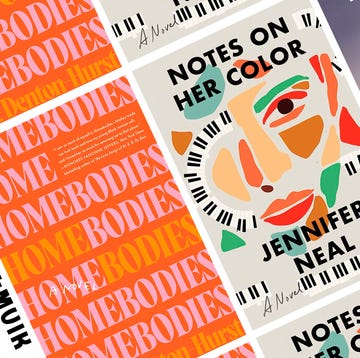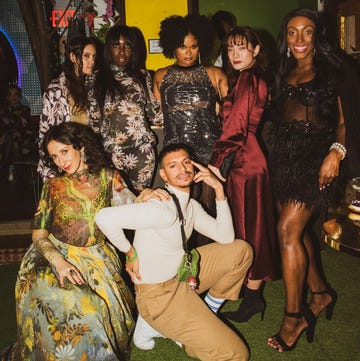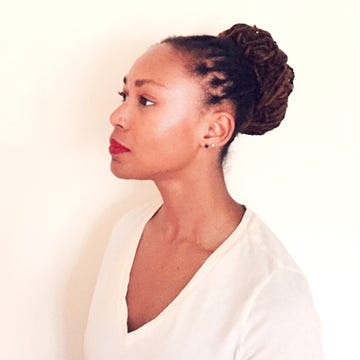Dallas is special is a phrase I heard many times over the four days I spent at the annual Dallas Art Fair, an event making waves as the next international art destination in the U.S. The fair has grown considerably over the 15 years since it launched; in 2011, it had 35 exhibitors, while this year it had 90, including major galleries such as Perrotin, Grimm, and Galerie Max Hetzler. It even had its first satellite fair.
Dallas is the fastest-growing metro area in the country, with a strong collector base. It’s unquestionably an art town on the rise—the next Miami, even? Each time I mentioned this to locals, I was met with an explosion of laughter and the overwhelming consensus that no, Dallas will never stop being Dallas. But I’m not so sure. The fair is beloved for its quintessential Dallas-ness: warmth, Southern hospitality, and openness. But as the city and the fair both increase in size, we have to ask: Openness for whom?
This year, no Black-owned Dallas galleries were invited to exhibit at the fair. In fact, only two exist—a strange reality given that Dallas is ranked among the top 10 most diverse cities in America. But Dallas, like many Southern cities, suffers from a thorny past. Its legacy of segregation lingers in the bones of its infrastructure and is visible in the continued struggle of the Black arts community to be seen and heard by those with power (predominantly privileged whites). “It’s been a slow crawl,” Valerie Gillespie told me. She owns Pencil on Paper Gallery. “But there’s been moments of [people], especially Black women, opening galleries and doing things for Black artists, which I’ve been so grateful for because I feel I’m where I am now because of them.”
More From Harper's BAZAAR

While there is a long line of trailblazing Black women who have historically created spaces for their community in Dallas, they did so against a tidal wave of oppression. In recent years, both Gillespie and the sole other Black female gallerist in town, Daisha Board, have faced discriminatory lending practices and had to hire white realtors to gain access to spaces in Dallas. Unemployed at the time and a mother of three, Board was never able to obtain a loan and had to pull $75,000 from the personal savings she shared with her husband to secure a space.
When she found out she wouldn’t be included in this year’s fair, Board organized a group show called “We ARE The Space” to run at her new downtown gallery over the same dates as the bigger event. She intended it as, "the visual equivalence of taking up space. A contemporary deliberation of representation and form." Board is known for putting on shows with a message. Last August, she held a solo show called, "Defiant," for local Dallas artist Jeremy Biggers, whose painting Defiant 004 was bought by Dallas collectors Marlo and Jeff Melucci, an important interracial collector couple with a relentless dedication to championing underrepresented artists in their city and beyond. “Daisha Board is very much representing the BIPOC voices [in Dallas] and is intentional about the space she’s curating,” Marlo told me. “She wants everyone to feel like whoever steps foot in her space, you belong there.”
The Meluccis served on the board of community advisors that chose the winning artworks for this year’s acquisition fund—a collaboration between the Dallas Museum of Art and the Dallas Art Fair. The fund was modeled after the Outset Frieze Tate Fund and allows artists the opportunity to have their work acquired by the DMA. It’s a unique way for the fair and the museum to engage with local Dallas artists. Katherine Brodbeck, Hoffman Family senior curator of contemporary art at the DMA, who is white, says the museum tries to acquire local artists every year at the fair. They often acquire artists who don’t have any museum representation at all. “We’re really sensitive to our role in maintaining the [Dallas art] ecosystem,” she told me.
This year, one of those local artists was Riley Holloway. It was his first museum acquisition—a career milestone for an emerging artist. The painting acquired by the museum, Records on Repeat, is based on a family photograph in which Holloway and his father exchange a tender moment one long-ago Christmas Day. Holloway is a dreamer, but he’s also a realist. When I asked him what it meant to him to have this work acquired by the museum, he said, “There is a part of me that wonders what a DMA acquisition will do for me here locally, because I’ve done much better outside of Dallas than I have inside of Dallas.” While his work has sold well at the Dallas Art Fair in the past, the buyers aren’t usually locals.
I brought up Johnny Floyd, an Atlanta-based artist who’s repped by Dallas’s Conduit Gallery. In addition to showing at the fair this year, Floyd had a piece acquired in 2021 and mentioned that while an acquisition is meaningful and, as Holloway put it, “a great résumé pad,” what happens after is even more important.
As an emerging artist of color who didn’t fully understand the industry’s inner workings, Floyd felt lost after the acquisition. “Dallas has an opportunity with this fair and with the acquisition fund,” he says—the opportunity to help artists navigate the current system. “After [the acquisition], I didn’t have any connection or infrastructure or someone to be like, Okay, now that this happened, let’s do this.” He suggests the museum could coordinate a residency of local artists whose works were previously acquired to show together in a booth.
Holloway agrees, adding that the DMA could offer local artists whose work they’ve acquired more follow-up opportunities, like solo shows or programming that would help them capitalize on the acquisition. Like all artists of color in Dallas, he has had to create his own blueprint through a grassroots network of smaller community programs and spaces that will allow artists to curate and show their works in the hope of gaining the attention of larger Dallas galleries, like Erin Cluley Gallery, which now represents him. Holloway is not entirely hopeful a proper infrastructure will exist in his lifetime, however. “Being in Dallas this long, I’m not expecting there to be one,” he says.
In the past, the acquisition fund has led to massive career growth for some local artists, like Evita Tezeno. Since having a piece acquired last year by the DMA, Tezeno has won a Guggenheim Fellowship, and her first solo museum exhibition opens at the Houston Museum of African American Culture this month. But though Tezeno has been making art in Dallas for decades, it was Los Angeles gallerist Luis De Jesus who first took note of her work on Instagram, signing her after a sold-out show in his space.
“Why is Dallas so afraid of their own talent?” Liliana Bloch, a local Latinx gallerist, says to me on a call. Her eponymous gallery has shown with the fair four times from 2018 to 2021, but wasn’t invited back the last two years—though her roster of artists includes the likes of Alicia Eggert, Alicia Henry, and several other established artists. While she doesn’t feel the decision has to do with discrimination and says she enjoyed her time exhibiting at the fair in the past, Bloch does believe that Dallas as a whole needs to let go of old ways. “The more generic you make a city, the less you’re going to bring to the world. Diversity is what makes things interesting."
The white elitism of the art world has only recently been taken to task. When combined with Dallas’s entrenched history of segregation and racial inequity, the effect is amplified and resounding. Progress is happening in the Dallas art scene, but not fast enough. Particularly vulnerable to the slow pace of progress are local artists of color, like Riley Holloway, who struggle to make a path for themselves where historically there hasn’t been one. And why shouldn’t they question the tokenism of the one inroad offered to them? “The art world is an exclusive, patriarchal place,” Johnny Floyd told me. “It’s cool that we have this acquisition fund, but there’s so many people being left out of the conversation because we can’t even have access to it.”
But Floyd and everyone else I spoke with also love the fair. Overwhelmingly, I was told it was a boon to Dallas and a wonderful place to make lasting connections and friendships. How then, does something so beloved of its community remain loyal to it? And what is the fair’s responsibility to the Dallas art scene when it comes to deciding which galleries get admitted into the fair—and therefore, which artists get exposure—and which don’t? Kelly Cornell, the fair’s director, says, “It’s very conscious the way we’re choosing and selecting and keeping galleries [at the fair]. As long as people are showing great booths and doing really strong presentations, we’re going to keep supporting them.”
The origins of the Dallas Art Fair and Dallas’s art world lie in a vanguard white collector base that eschews the spotlight in favor of building a unique local scene. The Rachofskys, the Roses, and the Hoffmans have gone on to influence the next generation of (white) Dallas collectors.
“[The Hoffmans] have a very civic-minded patron philosophy. And it’s affected the Dallas art culture so significantly,” Claire Gogel told me. She and her husband, Brian, collect almost exclusively marginalized artists (women and artists of color). I asked her what spoke to her about these narratives, and she grew passionate talking about the injustices playing out in North Texas, saying, “Art can communicate the challenging things that should be discussed. You can put it on your wall and have these conversations about it, and it really forces people to confront some of these issues.”
I came across similar versions of this ethos in every Dallas collector’s home I visited. Chief Experience Officer of Mary Kay Sheryl Adkins-Green brought up Texas’s attack on education, saying, “Knowing that some books and information are in jeopardy in the schools, we need art that can tell the stories.” Marlo Melucci told me, “It’s important as an investor in this, that you are clear about what it is that resonates with you, because where you spend your dollars reinforces what things will look like next time around. We see this as an act of social justice.” David Liu, a gregarious Asian-American collector recently listed as a young collector to watch by Cultured magazine, told me that what spurred his collecting was finally being able to see himself reflected in the artwork being sold. He cited the fair as a huge part of his success: “The fair shows art that opens dialogues.”
But while it’s true the art in the fair is sparking important conversations around inequality and identity among fairgoers and, perhaps, gallerists, those same conversations don’t seem to be playing out between Dallas’s artistic institutions and the local art scene. Without an open dialogue about the city’s entrenched racial inequity and transparency around the fair’s rubric for gallery selection, it’s easy to see how the fair’s lack of representation of the Black and Latino arts communities might feel discriminatory. As Marlo Melucci put it, “There’s an underlying tension beneath all of this. Whether people are speaking about this, whether they don’t want to confront it, it’s very much here. It is. There are more voices here, and we’re not going to let you forget that.”
















